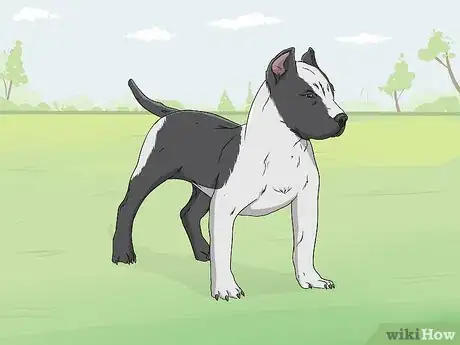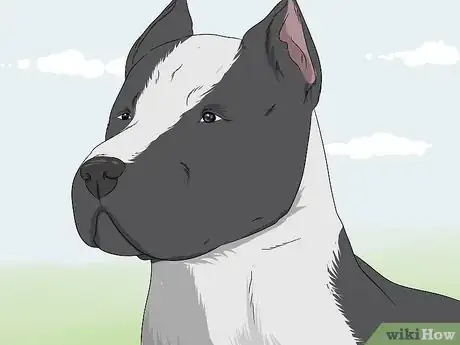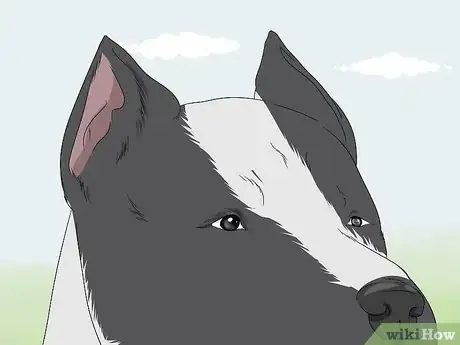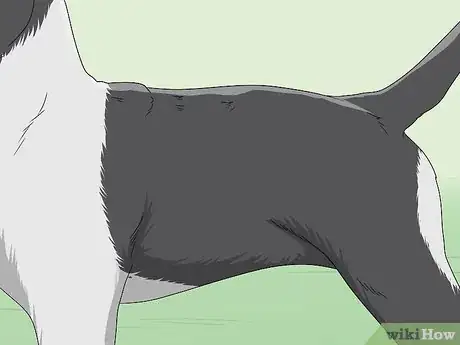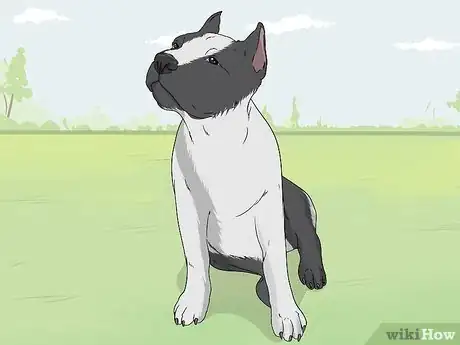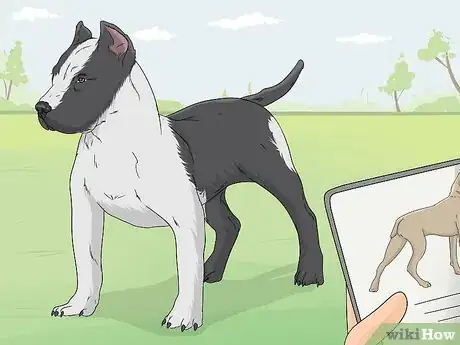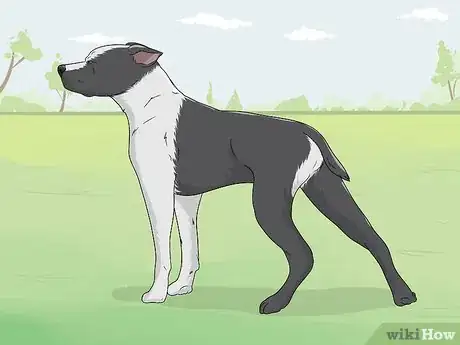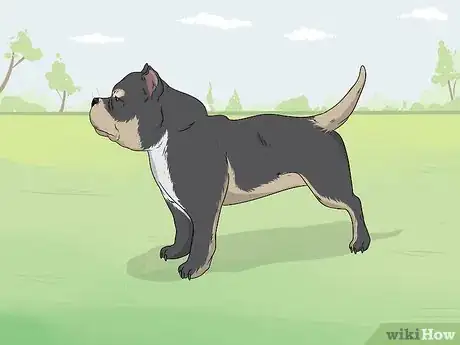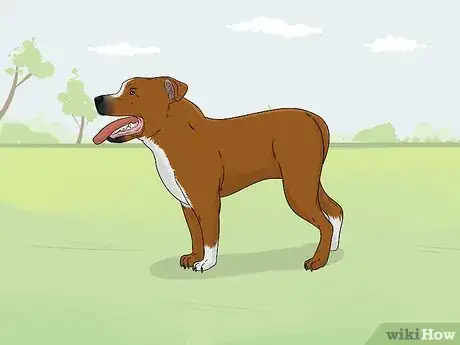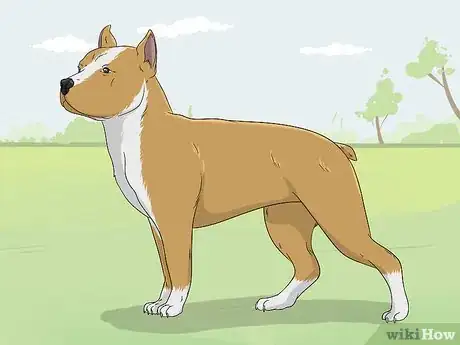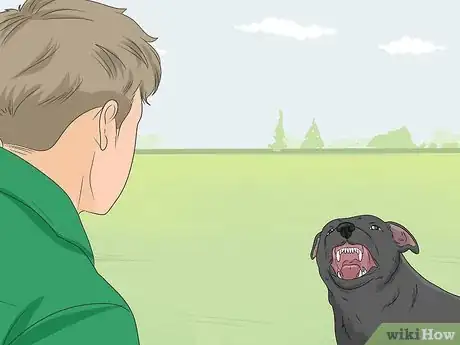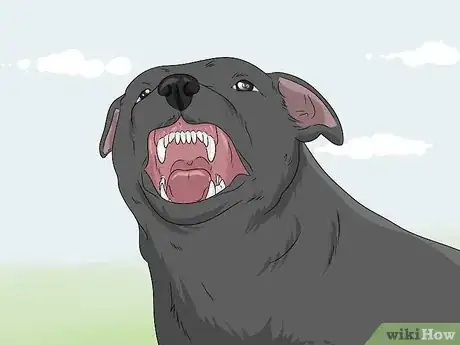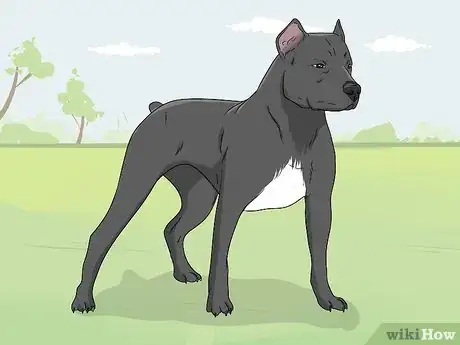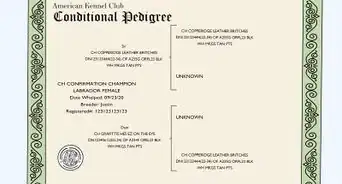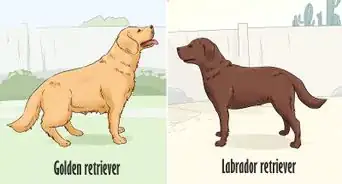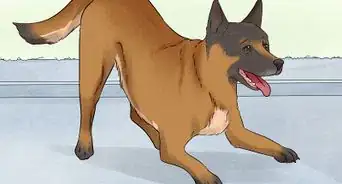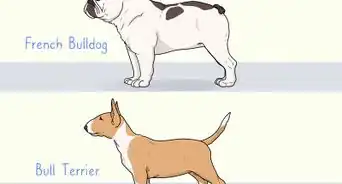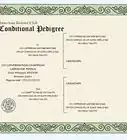This article was co-authored by Pippa Elliott, MRCVS and by wikiHow staff writer, Christopher M. Osborne, PhD. Dr. Elliott, BVMS, MRCVS is a veterinarian with over 30 years of experience in veterinary surgery and companion animal practice. She graduated from the University of Glasgow in 1987 with a degree in veterinary medicine and surgery. She has worked at the same animal clinic in her hometown for over 20 years.
There are 12 references cited in this article, which can be found at the bottom of the page.
This article has been viewed 119,208 times.
It’s harder than you might think to pick out a pitbull, because “pitbull” isn’t actually a recognized dog breed. It’s more accurate to say that there are various “pitbull-type” dogs that often share some physical similarities, such as muscular bodies, thick necks, and wedge-shaped heads. Pitbulls have earned a bad reputation among some as aggressive and dangerous, but the truth is that aggression is much more of an individual dog trait. If you’re concerned about being able to identify an aggressive dog, look for common signs of aggression—like snarling—rather than trying to figure out if the dog is a “dangerous” pitbull.
Steps
Identifying “Pitbull-Type” Characteristics
-
1Look for a muscular, athletic, well-defined body appearance. Pitbull-type dogs can vary greatly in size, but they usually look athletic and powerful regardless of size. You’ll likely see broad shoulders and an angular physique, although the dog’s diet, lifestyle, and health status may impact its muscular appearance.[1]
- Terms like “thick,” “strong,” and “well-built” should come to mind when you see a pitbull-type dog.
- Pitbull-type dogs aren’t linked by a particular breed, but rather a shared ancestry from dogs that were bred for fighting. The term “pitbull” emerged roughly 200 years ago in England to refer to dogs that were used to fight chained bulls or bears in pits—so-called “sports” known as “bull-baiting” or “bear-baiting.”[2]
- The dog breed closest in appearance to pitbulls is the American Staffordshire Terrier. However, these dogs have more standardization in their size.[3]
-
2Check for a broad, wedge-shaped head and thick neck. The dog’s head will probably look wide and slightly rounded from the front, but look like a wedge from the side due to a long muzzle and low forehead. This head shape, like many characteristics, comes from pitbull-type dogs’ fighting heritage.[4]
- Keep in mind that pitbull-type dogs were bred to have good physical characteristics for fighting, but that doesn’t mean they are natural fighters that are inherently dangerous. Pitbull-type dogs that are properly cared for and trained are rarely dangerous.[5]
Advertisement -
3Expect to see deep-set eyes and high-set ears. The eyes usually have an oval or almond-shaped appearance and are well-protected by the dog’s muzzle and brow. Likewise, the ears are typically set back and high on the head—as with the eye shape and position, this offered some protection while fighting.[6]
- Some people still crop (cut short) the ears of pitbull-type dogs, but this is a declining practice.
-
4Look for a single, short, and smooth or bristled coat. Nearly all pitbull-type dogs have single coats, meaning there is no undercoat. The single coat typically remains naturally short and either smooth or bristly in texture.[7] Pitbull coats can range from light fawn, chocolate, black, white, tan, brindle, or a combination of these colors.[8]
- A pitbull-type dog’s coat accentuates its muscular appearance instead of concealing it.
-
5Use character trait identifiers as loose guidelines, not facts. Depending on who you ask, pitbull-type dogs can be called “loyal,” “friendly,” “fun,” and “smart,” or “aggressive,” “domineering,” “unpredictable,” and “temperamental.” Dogs, like people, are individual beings with unique character traits, so don’t put much stock in picking out a pitbull by its personality.[9]
- On a very general level, pitbull-type dogs do tend to be very active and very accepting of training—which can lead to positive or negative character traits, depending on how they’re treated and trained.
- Make sure to provide your pitbull with plenty of positive socialization experiences while they are young. This is especially important for pitbulls as they have a bad reputation among some people, so even the smallest instance of bad behavior may reinforce fears about them.
-
6Accept the limitations of all “pitbull” identification techniques. Because “pitbull” is not a defined breed, visual indicators simply aren’t very reliable. Dogs without a pitbull-type background are frequently mis-identified as pitbull-types, and vice versa, even by experts. The fact of the matter is that “pitbull” is such a vague term that there is no agreed-upon way to define it.[10]
- Municipalities that ban “pitbulls” often use visual checklists. A dog that matches 5 of 8 visual descriptors, or a majority of 15 descriptors, for example, may be deemed a banned dog.
- If you define a “pitbull” as descending from one of the 4 most widely-known pitbull-type breeds—American pitbull terrier, American Staffordshire terrier, Staffordshire bull terrier, or American bully—then DNA testing, breeding papers, or both can be helpful in defining a dog as such.
Tip: DNA testing will give you the most definitive answer about the dog’s breed. Purchase a dog DNA test online, swab the inside of the dog’s cheek, and mail the sample back to the company for processing. This will allow you to learn all about your dog's parentage.
Recognizing Common “Pitbull-Type” Breeds
-
1Pick out an American pitbull terrier by its size and features. Adults of this mid-size breed carry many of the physical traits generally associated with pitbull-types, such as wedge-shaped faces and muscular builds. They typically reach 17–21 in (43–53 cm) in height and 30–60 lb (14–27 kg) in weight, and have no predominant coat colors or patterns—that is, they can be practically any color.[11]
- Of the 4 breeds most commonly called “pitbull-type,” the American pitbull terrier is probably the breed the average person would most likely identify as a “pitbull.”
Did You know? The American pitbull terrier was first recognized as a separate breed from pitbulls in general in the late 1800s.
-
2Identify the American bully as a slightly smaller American pitbull terrier. The American bully is a recent offshoot of the American pitbull terrier, recognized as a separate breed only in the early 2000s. Adults in this breed are usually slightly smaller in height and weight than American pitbull terriers, on average reaching 16–20 in (41–51 cm) in height. Therefore, they have a slightly stockier appearance.[12]
- Like American pitbull terriers, American bullies can be practically any color.
-
3Pick out a Staffordshire bull terrier as an even smaller and stockier breed. The Staffordshire bull terrier was first given breed status in the 1970s. This breed has similar physical traits to American pitbull terriers and American bullies, but has an even stockier appearance and is even smaller at, on average, 14–16 in (36–41 cm) in height and 24–38 lb (11–17 kg) in weight.[13]
- Despite their smaller stature and stocky appearance, Staffordshire bull terriers still have a very muscular and powerful look.
- This breed can also come in any color, but is most likely to be white, black, brown, or reddish in coat color.
-
4Identify an American Staffordshire terrier’s pairing of size and stockiness. While also on the stocky side like Staffordshire bull terriers, this breed is closer in size to American bullies, averaging 17–19 in (43–48 cm) in height and 40–70 lb (18–32 kg) in weight. The American Staffordshire terrier (or “AmStaff”) breed was established in the late 1800s.[14]
- “Am Staffs” are often black, brown, or reddish, sometimes with sections of white, but can have practically any coat color.
-
5Treat “red nose” and “blue nose” as genetic traits, not breed differences. Some pitbull-type dogs, especially American pitbull terriers, have distinctive noses that are either charcoal gray or pinkish-red in color. Some dog-lovers view “red nose pitbulls” and “blue nose pitbulls” as distinct breeds, but this nose color is actually due to a recessive gene passed down to the pup. Spotting one of these unique nose colors is a good sign that you’re looking at a pitbull-type dog, though.[15]
- The dog’s coat color usually corresponds to its nose color in these cases. Blue nose pitbulls usually have coats in the charcoal gray range, while red nose pitbulls usually have reddish-brown or auburn coats.
Spotting Aggressive Signs in Any Dog
-
1Remain calm, still, and non-threatening whenever possible. Your instinct may be to run away from the dog or to shout and wave your arms at it. However, such actions typically make it more likely that the dog will escalate its aggression. Instead, try to stay as calm and still as you can, and avoid looking the dog directly in the eyes. Back away slowly if you can.[16]
- If a dog bites you and holds on, don’t try to wrestle yourself out of the bite unless you have no choice but to do so. If the attack continues, drop to the ground and assume a “turtle” pose if possible—tuck your head, arms, and legs against or beneath your body and expose primarily your back and backside.
-
2Check for growling, snarling, or baring of teeth. A low, guttural growl is a frequent sign of aggressive intent. So too is the dog showing its clenched teeth to you. When the two are combined into a snarl, it’s a near certainty that the dog is in an aggressive frame of mind.[17]
- Dogs typically do not show their teeth except when they feel threatened.
-
3Treat snapping or lunging as possible preludes to biting. A dog often begins its aggressive action by lunging without biting, possibly striking you with its nuzzle. Alternatively, it may nip at you—applying a quick, small bite. In some cases the aggression may subside at this point, while in others it may escalate.[18]
-
4Watch for the dog to become still and rigid. Before acting aggressively, a dog will often stiffen its body briefly. You’ll likely get the feeling that the dog is focusing intently on you, which is a pretty accurate assessment of the situation.[19]
- You might say that this is the moment when the dog’s “fight or flight” response kicks in, after which the dog is likely to either act aggressively or retreat.
Warning: Don’t mistake a wagging tail for signs of friendliness. A stiff wagging tail or a wagging tail held in mid-position can also indicate aggression.
Warnings
- Any dog deemed a "pitbull" by animal control officers is subject to banning, so make sure you're familiar with your local dog bans.⧼thumbs_response⧽
References
- ↑ https://webarchive.nationalarchives.gov.uk/20130402172631/http://archive.defra.gov.uk/wildlife-pets/pets/cruelty/documents/dogs-guide-enforcers.pdf
- ↑ https://www.pitbullinfo.org/pit-bulls-breeds-and-pictures.html
- ↑ https://www.akc.org/dog-breeds/american-staffordshire-terrier/
- ↑ https://webarchive.nationalarchives.gov.uk/20130402172631/http://archive.defra.gov.uk/wildlife-pets/pets/cruelty/documents/dogs-guide-enforcers.pdf
- ↑ https://www.pitbullinfo.org/pit-bulls-breeds-and-pictures.html
- ↑ https://webarchive.nationalarchives.gov.uk/20130402172631/http://archive.defra.gov.uk/wildlife-pets/pets/cruelty/documents/dogs-guide-enforcers.pdf
- ↑ https://webarchive.nationalarchives.gov.uk/20130402172631/http://archive.defra.gov.uk/wildlife-pets/pets/cruelty/documents/dogs-guide-enforcers.pdf
- ↑ https://adbadog.com/pit-bull-color-chart/
- ↑ https://www.pitbullinfo.org/pit-bulls-breeds-and-pictures.html
- ↑ https://www.sciencedirect.com/science/article/pii/S109002331500310X
- ↑ https://www.ukcdogs.com/american-pit-bull-terrier
- ↑ https://www.ukcdogs.com/american-bully
- ↑ https://www.ukcdogs.com/staffordshire-bull-terrier
- ↑ https://www.akc.org/dog-breeds/american-staffordshire-terrier/
- ↑ https://www.dogvills.com/difference-between-blue-nose-and-red-nose-pit-bulls/
- ↑ https://www.cbsnews.com/news/if-aggressive-dog-threatens-you-know-what-to-do/
- ↑ https://www.aspca.org/pet-care/dog-care/common-dog-behavior-issues/aggression
- ↑ https://www.aspca.org/pet-care/dog-care/common-dog-behavior-issues/aggression
- ↑ https://www.aspca.org/pet-care/dog-care/common-dog-behavior-issues/aggression
